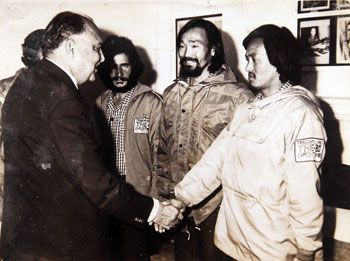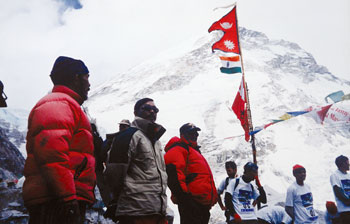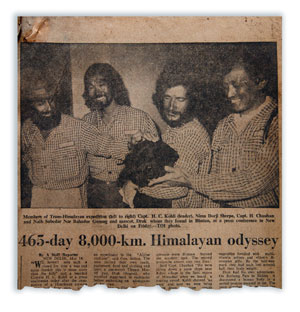Determination, team spirit, and love for adventure took four soldiers on a never-before attempted journey through the Himalayas

General Srinivas Kumar Sinha greets HC Kohli (not seen) H Chauhan, ND Sherpa, and NB Gurung at a reception in Shimla in May 1982.
1981: Four Indian Army men - captains HC Kohli (team leader), H Chauhan, Nima Dorji Sherpa, Nar Bahadur Gurung- set out to traverse the entire Himalayan range alpine style. If they succeed, they will be the first to complete the trans-Himalayan expedition, setting a new record.
1982: After 485 days of hiking through leech infested jungles in Arunachal Pradesh of north east India, trudging through vast stretches of snow, climbing three peaks, crisscrossing 48 passes and glaciers, and experiencing the mountain life of three countries- India, Bhutan, Nepal- the men complete their mission by unfurling the Indian flag at 6,110m in Karakoram Pass, Ladakh. At a press conference in Delhi, the team introduces their fifth member Druk, a Tibetan mastiff found in Bhumthang valley of Bhutan who accompanied the soldiers as they completed the 8,000km journey. Druk seems unfazed by all the attention.
More than 30 years since the team completed its phenomenal 1981 expedition, we meet Nar Bahadur Gurung (pic, below) in Kathmandu. Born in Pokhara, Gurung joined the Indian Army in the 1970s. After retirement in 2000, the 66-year-old father of four spent a few months in Darjeeling before heading home to start a trekking agency with a friend.
Gurung’s face lights up as he sets out a collage of photos, scraps of old newspaper clippings, and route maps in front of us and begins to reminisce about the journey that made history and inspired a generation. “Ours was one of the most difficult expeditions of all time,” he says.
Sponsored by the Indian Army Adventure Foundation, the expedition was the brain-child of its director, Lt Col SS Singh, who worked closely with the four men in outlining possible routes and also supervising the training session. Says Gurung: “Some of my fondest memories in the army are from the time I spent at the mountaineering and skiing institute in Kashmir. And the day I found out I had been chosen for the expedition, I was the happiest man alive.”

MISSION POSSIBLE: The team at the Everest Base Camp in June 1981
The team set out on 15 January 1981 from Gelling at the Indo-Tibet border in Arunachal Pradesh. From there on they marched to Bomdila, before crossing into Paro and Thimpu in Bhutan, Gangtok in Sikkim, and entering Nepal via the Kanchenjunga range. In the Nepal circuit of the expedition, the team passed through Makalu Base Camp, Sherpini Col, Baruntse Glacier, West Col, and Amphulaptsa Pass to Everest Base Camp, before coming down to Namche Bajar, and heading up to Tashi-Laptsa Pass to Rolwaling Himal and finally ending their 15 months long journey in Ladakh.
We ask the ex-army man what was most challenging during the journey? “The snow,” he replies instantly. It was snow that almost claimed their lives, twice. The first time an avalanche caught the team off guard in the Everest region and the second time, it swept two of them in Spiti valley in Himachal Pradesh where the team was skiing.

Druk is seen here with the team in a newspaper clipping from May 1982.
Luckily, except for the loss of equipment and Kohli’s camera, there were no other casualties. Surviving on dehydrated vegetables and food, Gurung playfully admits, was another big challenge.
Wasn’t it tough living in rugged terrain, temperature extremes, and rooming in a single tent with three other men? “All of us had immense determination. No matter how tough things got, we always stayed focused on our goals and that is why we were successful,” he explains.
Of the remaining members, ND Sherpa passed away in the late nineties, Kohli like Gurung runs a trekking agency in the UK, and Chauhan is serving as the president of the Indian Mountaineering Foundation. After the success of the Indian Army’s expedition, others followed.
That same year, Peter Hillary and his team set out to trek from Kanchenjunga to K2 in Pakistan, followed by Arlene Blum and Hugh Swift in 1982 who walked from Bhutan to Ladakh. A British women’s team also walked the route in 1983 starting from Sikkim, and in 1991, Australian Sorrel Wilby and her husband Chris Ciantar completed the 6,500 km journey from the Indus Valley in Pakistan to Arunachal Pradesh.
Given a chance would Gurung like to do this all over again? “Absolutely,” he replies without hesitating.